
The Project Gutenberg EBook of Mozart, by Thomas Tapper
This eBook is for the use of anyone anywhere at no cost and with
almost no restrictions whatsoever. You may copy it, give it away or
re-use it under the terms of the Project Gutenberg License included
with this eBook or online at www.gutenberg.net
Title: Mozart
The story of a little boy and his sister who gave concerts
Author: Thomas Tapper
Release Date: December 5, 2010 [EBook #34582]
Language: English
Character set encoding: ISO-8859-1
*** START OF THIS PROJECT GUTENBERG EBOOK MOZART ***
Produced by Juliet Sutherland, Ernest Schaal, and the
Online Distributed Proofreading Team at http://www.pgdp.net


Directions for Binding
Enclosed in this envelope it the cord and the needle with which to bind this book. Start in from the outside as shown on the diagram here. Pass the needle and thread through the center of the book, leaving an end extend outside, then through to the outside, about 2 inches from the center; then from the outside to inside 2 inches from the center at the other end of the book, bringing the thread finally again through the center, and tie the two ends in a knot, one each side of the cord on the outside.
THEO. PRESSER CO., Pub's., Phila., Pa.
MOZART
The Story of
A Little Boy and His Sister
Who Gave Concerts
This Book was made by
Philadelphia
Theodore Presser Co.
1712 Chestnut Str.
Copyright, 1915, by Theodore Presser Co
Printed in U. S. A.
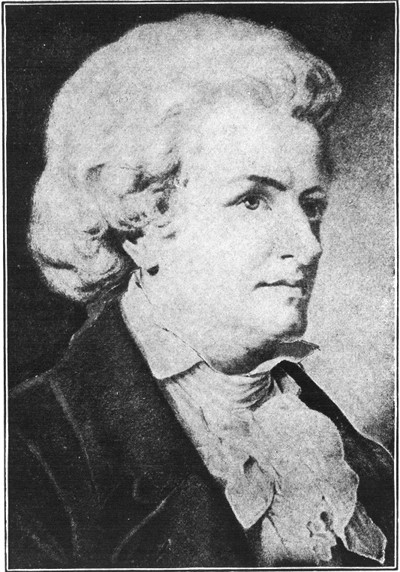
BORN
DIED
[Pg 3]
MOZART
The composer whom we call WOLFGANG AMADEUS MOZART was called Wolferl when he was a little boy.
He had a sister, MARIA ANNA, who was called NANNERL.
Nannerl was five years older than her brother. She had lessons from her father on a kind of piano called a harpsichord.
Here is a picture of one.
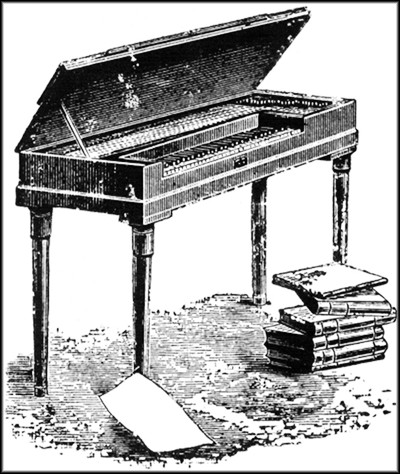
[Pg 4]
When Wolferl was three years old he used to listen to Nannerl's playing. He always watched and listened when Papa Mozart gave her a harpsichord lesson.
Little as he was, he would often go to the harpsichord and try to pick out tunes with his chubby fingers. His father noticed that Wolferl could remember quite a little of the music that Nannerl was practising.
And here is a picture of Wolferl trying to reach the keys so as to play the melody of his sister's lesson.
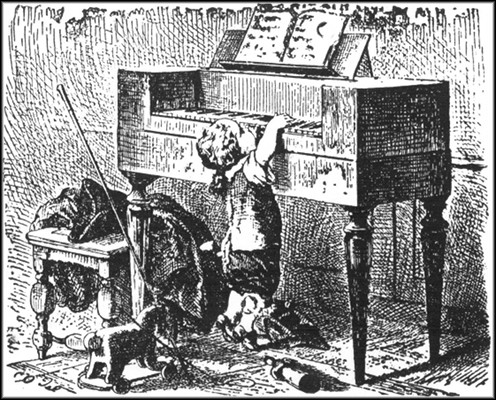
When Wolferl was four years old he began to take lessons.
While he practised no one ever spoke to him because he was so serious about it. If other children came to play with Nannerl he would make music for their games and marching; playing in strict time all the while.
[Pg 5] Here is Nannerl's picture when she grew up to be a young lady.
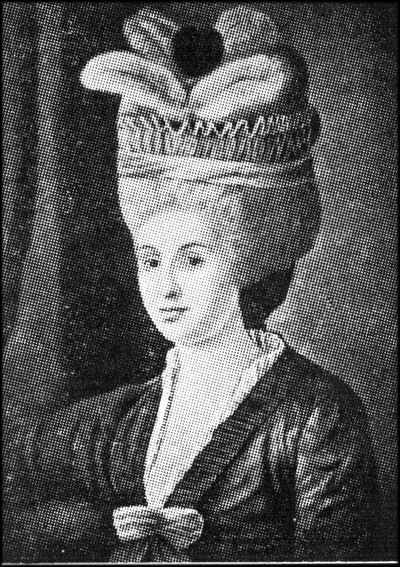
Father Mozart loved both of his children deeply and often played with them. The violin was the instrument he liked best and little Mozart had daily lessons in his home. Here we see him playing while his sister sings.
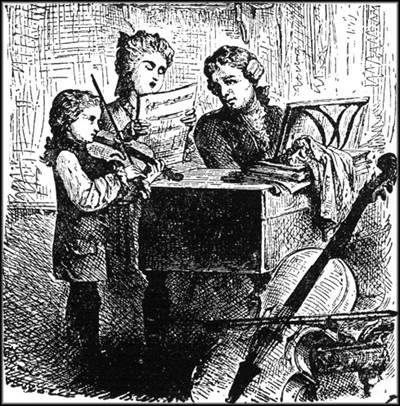
[Pg 6] In this picture we see Papa Mozart, who was a very fine player on the violin. Wolferl and Nannerl are playing the piano.
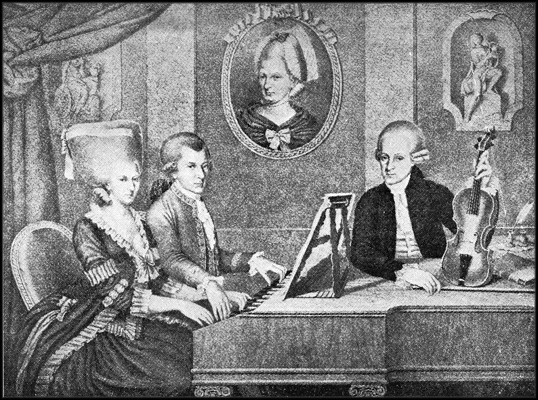
When Wolferl was nearly six his father took him and Nannerl on a concert tour. Everybody wanted to hear them play and they gave many concerts.
Wolferl spent all his boyhood with his music. He went to many places to play, even as far from Salzburg, in Austria (where he was born), as to Paris and London.
Everywhere he went people were happy to see him and his sister and to hear them play. And they, too, were happy to play because they loved the music so much.
[Pg 7] When they reached Vienna they played for the Emperor and Empress.
When Wolferl was presented to the Empress he jumped up into her lap and kissed her.
Wolferl was always busy composing music. But he played games and had a good time just like any other boy. When he was busy with his music, however, he never let his thoughts go to anything else.
But we must not go too fast, for we want to see how Wolferl is growing up.
Here is his picture when he was five years old and beside it another when he was eight years old. Do you see his wig and sword?
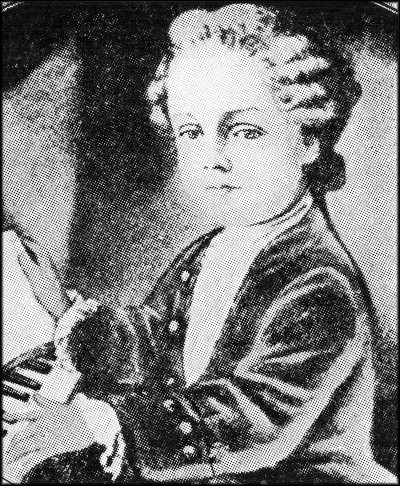
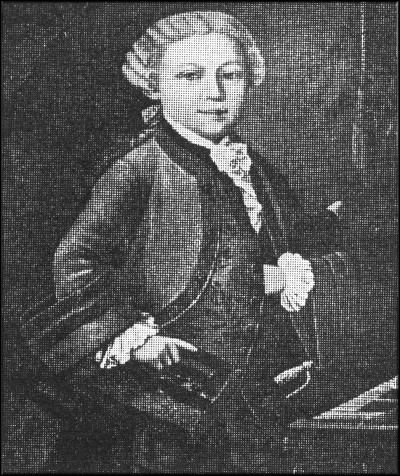
Everybody in Paris wanted to hear Wolferl play when they knew that he had come, so they asked him to read at sight; to play the bass part to a melody and to accompany a song without seeing the music.
[Pg 8] People also took great delight in asking him to play on the harpsichord with a cloth stretched over the keyboard so that he could not see the keys.
They all went to London to play for the King. The King wanted to see for himself how skilful little Mozart was, so he gave him pieces by Bach and Handel to play at sight. Mozart read them off at once. Here is a fine picture of the Mozart children when they played for the King and the Queen.
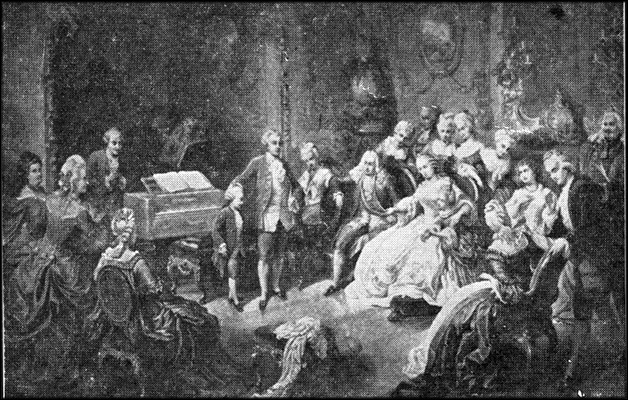
It must have been very fine for a little boy of seven to play for kings and queens. But Wolferl was not spoiled by it all. He was just a happy hearted boy all the time.
He always made it a rule to put his mind on what he was doing and do it the very best he knew how.
It is just as good a rule now as it was when he was alive.
[Pg 9] It is time now that we learned the birthday of Mozart. If we think of it every year on the 27th of January, it will be easy to remember it.
In what year was he born?
Here is another picture of Mozart in 1766. How old was he then? (Beethoven was born four years afterward.)
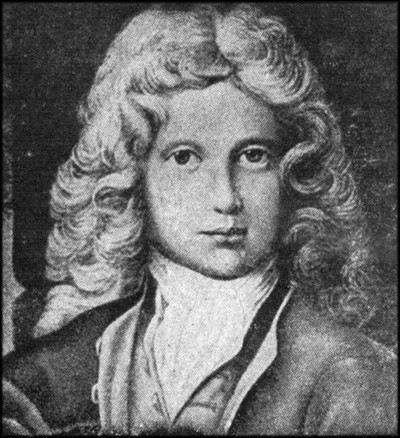
When anyone is always busy at one thing he soon gets a lot done. As Wolferl grew and kept on writing music all the time he made a great many pieces. Some were short like a song, others were long like an opera. He wrote for the piano, the violin and the voice. And he composed operas, symphonies and ever so many other kinds of music.
Mozart liked to be alone when he was working upon his compositions. He used to go to a little house on the edge of Vienna and lock himself in. [Pg 10] The people of the city of Salzburg, in Austria, took this house long after Mozart's death and moved it to a park where all may go to see it, just as we in America go to see the houses of William Penn, Lincoln and Washington.
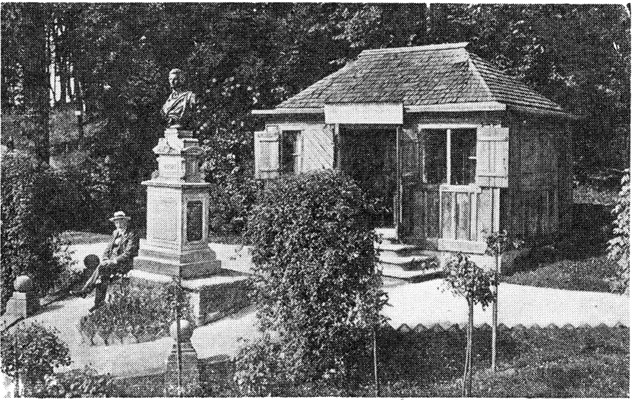
Can you remember, without turning back, the year in which Mozart was born?
Some other great musicians were alive at that time. And during his lifetime some were born who became great men.
In the year when Mozart was born both Handel and Haydn were living. And Haydn lived eighteen years after Mozart's death.
You can remember it by these lines:

[Pg 11] When Mozart was fourteen years old Beethoven was born. Mozart knew him and he knew Papa Haydn also, and they were very good friends.
In our own country there lived in Mozart's lifetime Benjamin Franklin and three Presidents of the United States—George Washington, John Adams and Thomas Jefferson.
I wonder if Washington ever heard of Mozart?
Perhaps we can best keep all these names together by looking at this page now and again.
| 1706 | Benjamin Franklin was born. |
| 1732 | Washington and Haydn were born. |
| 1736 | Patrick Henry was born. |
| 1743 | Thomas Jefferson was born. |
| 1750 | Bach died. |
| 1756 | WOLFGANG AMADEUS MOZART was born. |
| 1759 | Handel died |
| 1770 | Beethoven was born. |
| 1771 | Walter Scott was born. |
| 1790 | Franklin died. |
| 1791 | Mozart died. |
| 1809 | Joseph Haydn died. |
Isn't it fine to think of Mozart writing so much music, so many operas, symphonies and sonatas; traveling so much, meeting so many people and never being spoiled by it all.
[Pg 12] While he wrote many very great pieces of music, here is something he composed when he was five years old. He made up the pieces at the piano and his father wrote them down note for note in a little copy book.
FACTS ABOUT MOZART.
Read these facts about Wolfgang Amadeus Mozart and try to write his story out of them, using your own words. When your story is finished, ask your mother or your teacher to read it. When you have made it, copy it on pages 14, 15 and 16.
1. Full name: Wolfgang Amadeus Mozart.
2. Born Jan. 27, 1756; died Dec. 5, 1791.
3. The sister's name was Maria Anna.
4. Maria Anna was five years older than Wolfgang.
5. The pet names of the children were Wolferl and Nannerl.
6. Little Mozart loved to hear his sister play.
7. He started to study when he was four.
8. Mozart went on a concert tour with his sister when he was six years old.
[Pg 13] 9. When he was a child he visited many great cities, among them Paris, London and Vienna.
10. Handel and Haydn were living when Mozart was born.
11. Benjamin Franklin, George Washington, Patrick Henry, Thomas Jefferson and Walter Scott were all alive during the time of Mozart.
12. Mozart was five years old when he wrote his first piece.
SOME QUESTIONS.
1. In what country was Mozart born?
2. In what city was Mozart born?
3. Where did Mozart play before the Emperor and the Empress?
4. Did Mozart play games and have a good time like other boys?
5. Why did people ask Mozart to play upon the harpsichord with a cloth stretched over the keys?
6. Whose compositions did the King of England ask Mozart to play?
7. What great American patriot was born in the same year as Haydn?
8. Which lived the longer life, Haydn or Mozart?
9. Have you ever heard a piece by Mozart?
10. Was Mozart spoiled by meeting many people? [Pg 14]
THE STORY OF MOZART
Written by...................................
On (date)....................................
Write a short story about Mozart and his sister and copy it on these pages.
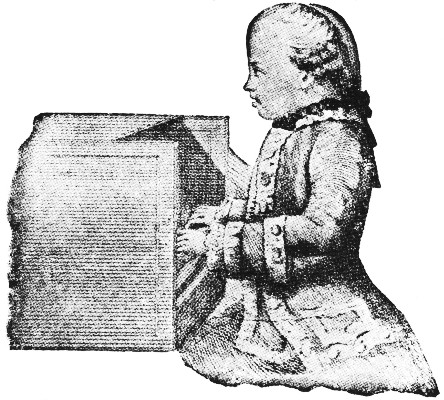
Transcriber's Notes:
On page 3, Mozart's sister's name was changed to "MARIA".
End of the Project Gutenberg EBook of Mozart, by Thomas Tapper
*** END OF THIS PROJECT GUTENBERG EBOOK MOZART ***
***** This file should be named 34582-h.htm or 34582-h.zip *****
This and all associated files of various formats will be found in:
http://www.gutenberg.org/3/4/5/8/34582/
Produced by Juliet Sutherland, Ernest Schaal, and the
Online Distributed Proofreading Team at http://www.pgdp.net
Updated editions will replace the previous one--the old editions
will be renamed.
Creating the works from public domain print editions means that no
one owns a United States copyright in these works, so the Foundation
(and you!) can copy and distribute it in the United States without
permission and without paying copyright royalties. Special rules,
set forth in the General Terms of Use part of this license, apply to
copying and distributing Project Gutenberg-tm electronic works to
protect the PROJECT GUTENBERG-tm concept and trademark. Project
Gutenberg is a registered trademark, and may not be used if you
charge for the eBooks, unless you receive specific permission. If you
do not charge anything for copies of this eBook, complying with the
rules is very easy. You may use this eBook for nearly any purpose
such as creation of derivative works, reports, performances and
research. They may be modified and printed and given away--you may do
practically ANYTHING with public domain eBooks. Redistribution is
subject to the trademark license, especially commercial
redistribution.
*** START: FULL LICENSE ***
THE FULL PROJECT GUTENBERG LICENSE
PLEASE READ THIS BEFORE YOU DISTRIBUTE OR USE THIS WORK
To protect the Project Gutenberg-tm mission of promoting the free
distribution of electronic works, by using or distributing this work
(or any other work associated in any way with the phrase "Project
Gutenberg"), you agree to comply with all the terms of the Full Project
Gutenberg-tm License (available with this file or online at
http://gutenberg.net/license).
Section 1. General Terms of Use and Redistributing Project Gutenberg-tm
electronic works
1.A. By reading or using any part of this Project Gutenberg-tm
electronic work, you indicate that you have read, understand, agree to
and accept all the terms of this license and intellectual property
(trademark/copyright) agreement. If you do not agree to abide by all
the terms of this agreement, you must cease using and return or destroy
all copies of Project Gutenberg-tm electronic works in your possession.
If you paid a fee for obtaining a copy of or access to a Project
Gutenberg-tm electronic work and you do not agree to be bound by the
terms of this agreement, you may obtain a refund from the person or
entity to whom you paid the fee as set forth in paragraph 1.E.8.
1.B. "Project Gutenberg" is a registered trademark. It may only be
used on or associated in any way with an electronic work by people who
agree to be bound by the terms of this agreement. There are a few
things that you can do with most Project Gutenberg-tm electronic works
even without complying with the full terms of this agreement. See
paragraph 1.C below. There are a lot of things you can do with Project
Gutenberg-tm electronic works if you follow the terms of this agreement
and help preserve free future access to Project Gutenberg-tm electronic
works. See paragraph 1.E below.
1.C. The Project Gutenberg Literary Archive Foundation ("the Foundation"
or PGLAF), owns a compilation copyright in the collection of Project
Gutenberg-tm electronic works. Nearly all the individual works in the
collection are in the public domain in the United States. If an
individual work is in the public domain in the United States and you are
located in the United States, we do not claim a right to prevent you from
copying, distributing, performing, displaying or creating derivative
works based on the work as long as all references to Project Gutenberg
are removed. Of course, we hope that you will support the Project
Gutenberg-tm mission of promoting free access to electronic works by
freely sharing Project Gutenberg-tm works in compliance with the terms of
this agreement for keeping the Project Gutenberg-tm name associated with
the work. You can easily comply with the terms of this agreement by
keeping this work in the same format with its attached full Project
Gutenberg-tm License when you share it without charge with others.
1.D. The copyright laws of the place where you are located also govern
what you can do with this work. Copyright laws in most countries are in
a constant state of change. If you are outside the United States, check
the laws of your country in addition to the terms of this agreement
before downloading, copying, displaying, performing, distributing or
creating derivative works based on this work or any other Project
Gutenberg-tm work. The Foundation makes no representations concerning
the copyright status of any work in any country outside the United
States.
1.E. Unless you have removed all references to Project Gutenberg:
1.E.1. The following sentence, with active links to, or other immediate
access to, the full Project Gutenberg-tm License must appear prominently
whenever any copy of a Project Gutenberg-tm work (any work on which the
phrase "Project Gutenberg" appears, or with which the phrase "Project
Gutenberg" is associated) is accessed, displayed, performed, viewed,
copied or distributed:
This eBook is for the use of anyone anywhere at no cost and with
almost no restrictions whatsoever. You may copy it, give it away or
re-use it under the terms of the Project Gutenberg License included
with this eBook or online at www.gutenberg.net
1.E.2. If an individual Project Gutenberg-tm electronic work is derived
from the public domain (does not contain a notice indicating that it is
posted with permission of the copyright holder), the work can be copied
and distributed to anyone in the United States without paying any fees
or charges. If you are redistributing or providing access to a work
with the phrase "Project Gutenberg" associated with or appearing on the
work, you must comply either with the requirements of paragraphs 1.E.1
through 1.E.7 or obtain permission for the use of the work and the
Project Gutenberg-tm trademark as set forth in paragraphs 1.E.8 or
1.E.9.
1.E.3. If an individual Project Gutenberg-tm electronic work is posted
with the permission of the copyright holder, your use and distribution
must comply with both paragraphs 1.E.1 through 1.E.7 and any additional
terms imposed by the copyright holder. Additional terms will be linked
to the Project Gutenberg-tm License for all works posted with the
permission of the copyright holder found at the beginning of this work.
1.E.4. Do not unlink or detach or remove the full Project Gutenberg-tm
License terms from this work, or any files containing a part of this
work or any other work associated with Project Gutenberg-tm.
1.E.5. Do not copy, display, perform, distribute or redistribute this
electronic work, or any part of this electronic work, without
prominently displaying the sentence set forth in paragraph 1.E.1 with
active links or immediate access to the full terms of the Project
Gutenberg-tm License.
1.E.6. You may convert to and distribute this work in any binary,
compressed, marked up, nonproprietary or proprietary form, including any
word processing or hypertext form. However, if you provide access to or
distribute copies of a Project Gutenberg-tm work in a format other than
"Plain Vanilla ASCII" or other format used in the official version
posted on the official Project Gutenberg-tm web site (www.gutenberg.net),
you must, at no additional cost, fee or expense to the user, provide a
copy, a means of exporting a copy, or a means of obtaining a copy upon
request, of the work in its original "Plain Vanilla ASCII" or other
form. Any alternate format must include the full Project Gutenberg-tm
License as specified in paragraph 1.E.1.
1.E.7. Do not charge a fee for access to, viewing, displaying,
performing, copying or distributing any Project Gutenberg-tm works
unless you comply with paragraph 1.E.8 or 1.E.9.
1.E.8. You may charge a reasonable fee for copies of or providing
access to or distributing Project Gutenberg-tm electronic works provided
that
- You pay a royalty fee of 20% of the gross profits you derive from
the use of Project Gutenberg-tm works calculated using the method
you already use to calculate your applicable taxes. The fee is
owed to the owner of the Project Gutenberg-tm trademark, but he
has agreed to donate royalties under this paragraph to the
Project Gutenberg Literary Archive Foundation. Royalty payments
must be paid within 60 days following each date on which you
prepare (or are legally required to prepare) your periodic tax
returns. Royalty payments should be clearly marked as such and
sent to the Project Gutenberg Literary Archive Foundation at the
address specified in Section 4, "Information about donations to
the Project Gutenberg Literary Archive Foundation."
- You provide a full refund of any money paid by a user who notifies
you in writing (or by e-mail) within 30 days of receipt that s/he
does not agree to the terms of the full Project Gutenberg-tm
License. You must require such a user to return or
destroy all copies of the works possessed in a physical medium
and discontinue all use of and all access to other copies of
Project Gutenberg-tm works.
- You provide, in accordance with paragraph 1.F.3, a full refund of any
money paid for a work or a replacement copy, if a defect in the
electronic work is discovered and reported to you within 90 days
of receipt of the work.
- You comply with all other terms of this agreement for free
distribution of Project Gutenberg-tm works.
1.E.9. If you wish to charge a fee or distribute a Project Gutenberg-tm
electronic work or group of works on different terms than are set
forth in this agreement, you must obtain permission in writing from
both the Project Gutenberg Literary Archive Foundation and Michael
Hart, the owner of the Project Gutenberg-tm trademark. Contact the
Foundation as set forth in Section 3 below.
1.F.
1.F.1. Project Gutenberg volunteers and employees expend considerable
effort to identify, do copyright research on, transcribe and proofread
public domain works in creating the Project Gutenberg-tm
collection. Despite these efforts, Project Gutenberg-tm electronic
works, and the medium on which they may be stored, may contain
"Defects," such as, but not limited to, incomplete, inaccurate or
corrupt data, transcription errors, a copyright or other intellectual
property infringement, a defective or damaged disk or other medium, a
computer virus, or computer codes that damage or cannot be read by
your equipment.
1.F.2. LIMITED WARRANTY, DISCLAIMER OF DAMAGES - Except for the "Right
of Replacement or Refund" described in paragraph 1.F.3, the Project
Gutenberg Literary Archive Foundation, the owner of the Project
Gutenberg-tm trademark, and any other party distributing a Project
Gutenberg-tm electronic work under this agreement, disclaim all
liability to you for damages, costs and expenses, including legal
fees. YOU AGREE THAT YOU HAVE NO REMEDIES FOR NEGLIGENCE, STRICT
LIABILITY, BREACH OF WARRANTY OR BREACH OF CONTRACT EXCEPT THOSE
PROVIDED IN PARAGRAPH 1.F.3. YOU AGREE THAT THE FOUNDATION, THE
TRADEMARK OWNER, AND ANY DISTRIBUTOR UNDER THIS AGREEMENT WILL NOT BE
LIABLE TO YOU FOR ACTUAL, DIRECT, INDIRECT, CONSEQUENTIAL, PUNITIVE OR
INCIDENTAL DAMAGES EVEN IF YOU GIVE NOTICE OF THE POSSIBILITY OF SUCH
DAMAGE.
1.F.3. LIMITED RIGHT OF REPLACEMENT OR REFUND - If you discover a
defect in this electronic work within 90 days of receiving it, you can
receive a refund of the money (if any) you paid for it by sending a
written explanation to the person you received the work from. If you
received the work on a physical medium, you must return the medium with
your written explanation. The person or entity that provided you with
the defective work may elect to provide a replacement copy in lieu of a
refund. If you received the work electronically, the person or entity
providing it to you may choose to give you a second opportunity to
receive the work electronically in lieu of a refund. If the second copy
is also defective, you may demand a refund in writing without further
opportunities to fix the problem.
1.F.4. Except for the limited right of replacement or refund set forth
in paragraph 1.F.3, this work is provided to you 'AS-IS' WITH NO OTHER
WARRANTIES OF ANY KIND, EXPRESS OR IMPLIED, INCLUDING BUT NOT LIMITED TO
WARRANTIES OF MERCHANTIBILITY OR FITNESS FOR ANY PURPOSE.
1.F.5. Some states do not allow disclaimers of certain implied
warranties or the exclusion or limitation of certain types of damages.
If any disclaimer or limitation set forth in this agreement violates the
law of the state applicable to this agreement, the agreement shall be
interpreted to make the maximum disclaimer or limitation permitted by
the applicable state law. The invalidity or unenforceability of any
provision of this agreement shall not void the remaining provisions.
1.F.6. INDEMNITY - You agree to indemnify and hold the Foundation, the
trademark owner, any agent or employee of the Foundation, anyone
providing copies of Project Gutenberg-tm electronic works in accordance
with this agreement, and any volunteers associated with the production,
promotion and distribution of Project Gutenberg-tm electronic works,
harmless from all liability, costs and expenses, including legal fees,
that arise directly or indirectly from any of the following which you do
or cause to occur: (a) distribution of this or any Project Gutenberg-tm
work, (b) alteration, modification, or additions or deletions to any
Project Gutenberg-tm work, and (c) any Defect you cause.
Section 2. Information about the Mission of Project Gutenberg-tm
Project Gutenberg-tm is synonymous with the free distribution of
electronic works in formats readable by the widest variety of computers
including obsolete, old, middle-aged and new computers. It exists
because of the efforts of hundreds of volunteers and donations from
people in all walks of life.
Volunteers and financial support to provide volunteers with the
assistance they need are critical to reaching Project Gutenberg-tm's
goals and ensuring that the Project Gutenberg-tm collection will
remain freely available for generations to come. In 2001, the Project
Gutenberg Literary Archive Foundation was created to provide a secure
and permanent future for Project Gutenberg-tm and future generations.
To learn more about the Project Gutenberg Literary Archive Foundation
and how your efforts and donations can help, see Sections 3 and 4
and the Foundation web page at http://www.pglaf.org.
Section 3. Information about the Project Gutenberg Literary Archive
Foundation
The Project Gutenberg Literary Archive Foundation is a non profit
501(c)(3) educational corporation organized under the laws of the
state of Mississippi and granted tax exempt status by the Internal
Revenue Service. The Foundation's EIN or federal tax identification
number is 64-6221541. Its 501(c)(3) letter is posted at
http://pglaf.org/fundraising. Contributions to the Project Gutenberg
Literary Archive Foundation are tax deductible to the full extent
permitted by U.S. federal laws and your state's laws.
The Foundation's principal office is located at 4557 Melan Dr. S.
Fairbanks, AK, 99712., but its volunteers and employees are scattered
throughout numerous locations. Its business office is located at
809 North 1500 West, Salt Lake City, UT 84116, (801) 596-1887, email
business@pglaf.org. Email contact links and up to date contact
information can be found at the Foundation's web site and official
page at http://pglaf.org
For additional contact information:
Dr. Gregory B. Newby
Chief Executive and Director
gbnewby@pglaf.org
Section 4. Information about Donations to the Project Gutenberg
Literary Archive Foundation
Project Gutenberg-tm depends upon and cannot survive without wide
spread public support and donations to carry out its mission of
increasing the number of public domain and licensed works that can be
freely distributed in machine readable form accessible by the widest
array of equipment including outdated equipment. Many small donations
($1 to $5,000) are particularly important to maintaining tax exempt
status with the IRS.
The Foundation is committed to complying with the laws regulating
charities and charitable donations in all 50 states of the United
States. Compliance requirements are not uniform and it takes a
considerable effort, much paperwork and many fees to meet and keep up
with these requirements. We do not solicit donations in locations
where we have not received written confirmation of compliance. To
SEND DONATIONS or determine the status of compliance for any
particular state visit http://pglaf.org
While we cannot and do not solicit contributions from states where we
have not met the solicitation requirements, we know of no prohibition
against accepting unsolicited donations from donors in such states who
approach us with offers to donate.
International donations are gratefully accepted, but we cannot make
any statements concerning tax treatment of donations received from
outside the United States. U.S. laws alone swamp our small staff.
Please check the Project Gutenberg Web pages for current donation
methods and addresses. Donations are accepted in a number of other
ways including including checks, online payments and credit card
donations. To donate, please visit: http://pglaf.org/donate
Section 5. General Information About Project Gutenberg-tm electronic
works.
Professor Michael S. Hart is the originator of the Project Gutenberg-tm
concept of a library of electronic works that could be freely shared
with anyone. For thirty years, he produced and distributed Project
Gutenberg-tm eBooks with only a loose network of volunteer support.
Project Gutenberg-tm eBooks are often created from several printed
editions, all of which are confirmed as Public Domain in the U.S.
unless a copyright notice is included. Thus, we do not necessarily
keep eBooks in compliance with any particular paper edition.
Most people start at our Web site which has the main PG search facility:
http://www.gutenberg.net
This Web site includes information about Project Gutenberg-tm,
including how to make donations to the Project Gutenberg Literary
Archive Foundation, how to help produce our new eBooks, and how to
subscribe to our email newsletter to hear about new eBooks.